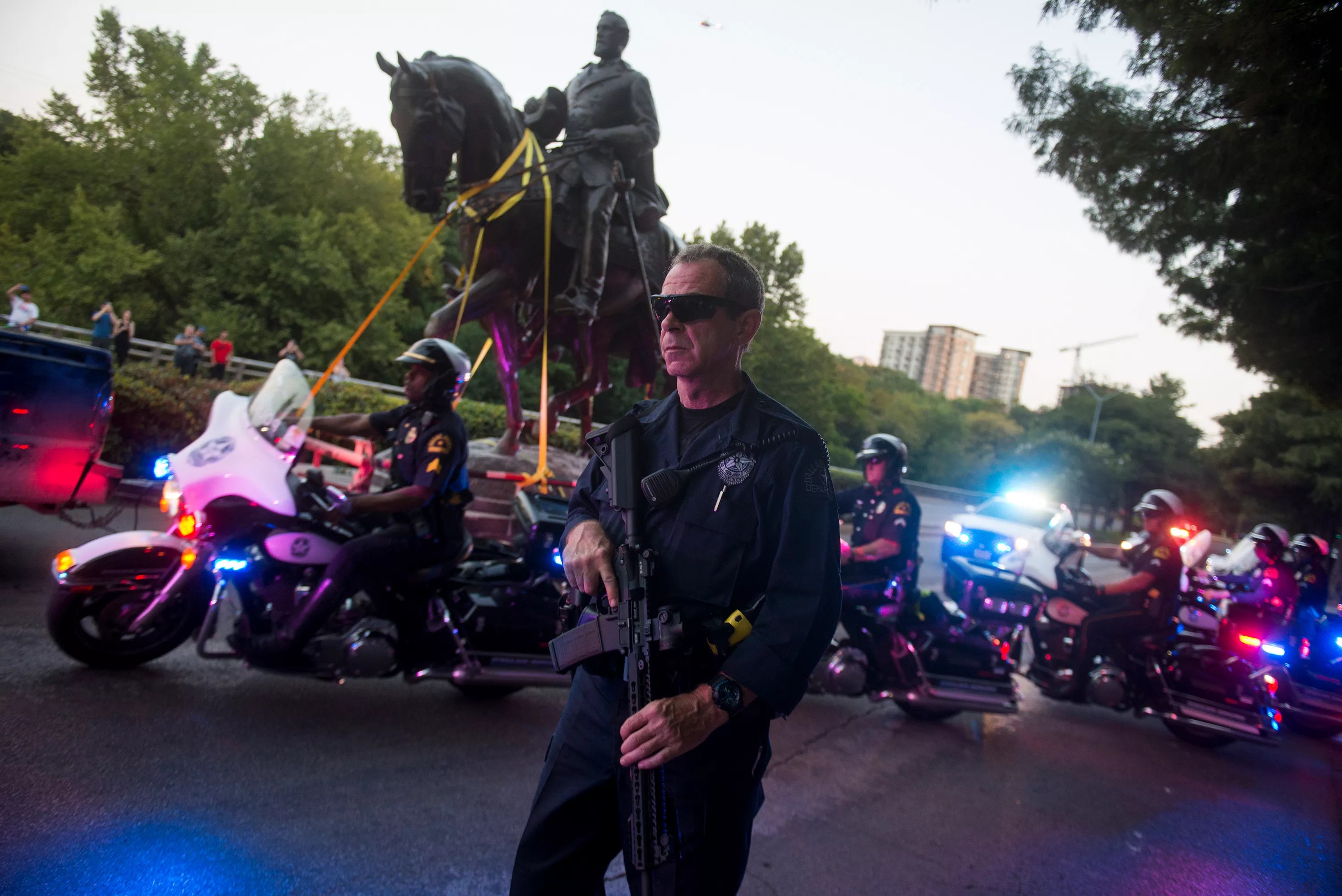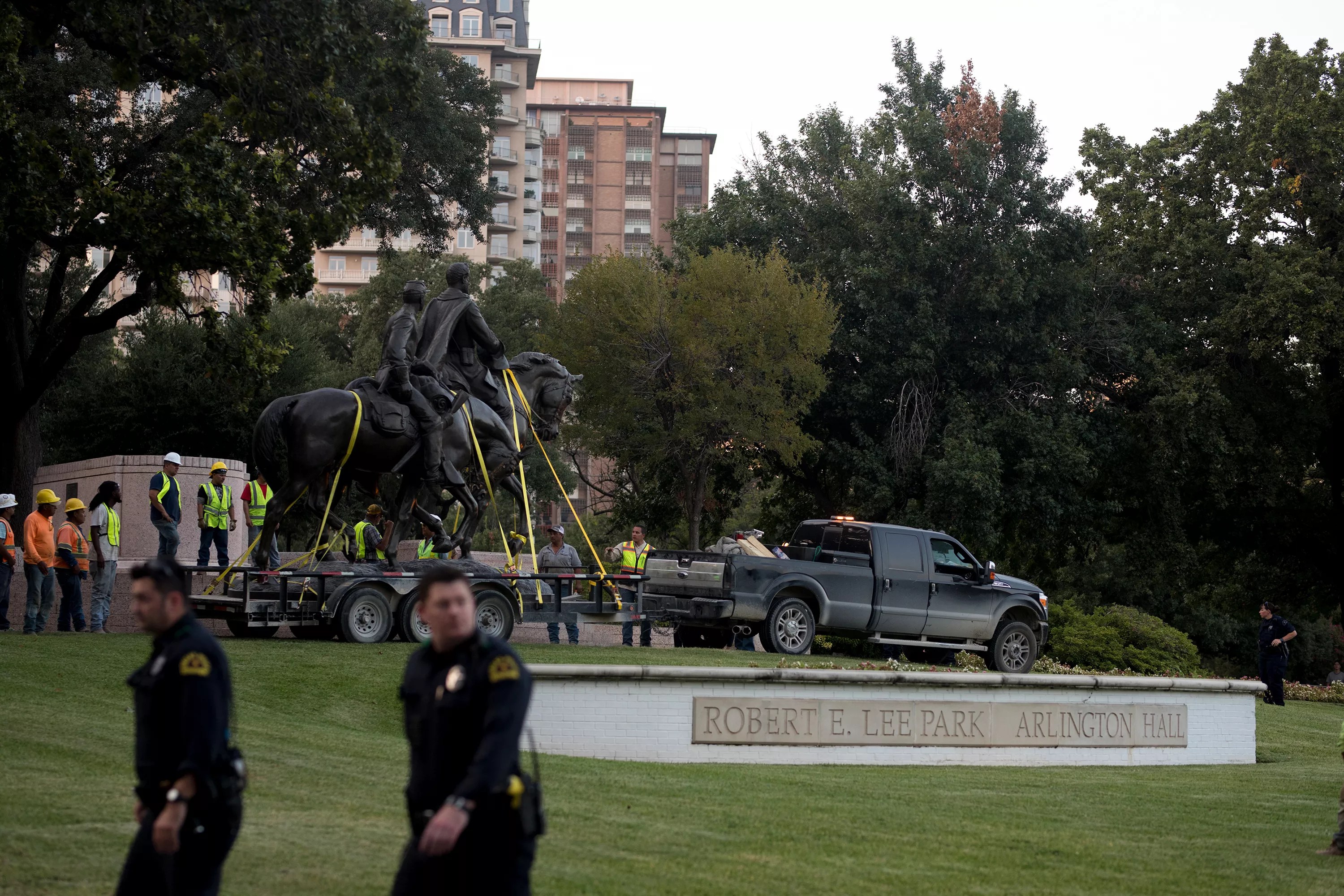
Brian Maschino

Audio By Carbonatix
After a weeklong melodrama of false starts, pratfalls and tragedy, the city finally succeeded Thursday night in evicting Confederate Gen. Robert E. Lee from a hill over Turtle Creek two miles north of City Hall. Spurred by the threat of a rally in defense of the statue scheduled for Saturday, the city finally figured out a way to remove it from Lee Park a week after the City Council voted for it to be taken down immediately.
In a series of earlier failed efforts, two cranes flunked the job, a third crane was ruined and a truck driver killed in a wreck, a federal judge ordered the removal stopped and then allowed it to proceed again, the city couldn’t find another crane for days and the city manager said he heard rumors that crane operators were being threatened.
And still the general sat on his horse, high on his stone plinth at Lee Park, like an enormous impacted molar that not even the most muscular dentist could extract from the city’s aching jaw.
When it came out Thursday, the removal was the quintessential anticlimax. The 81-year-old massive bronze figure – Lee astride his horse, Traveller, accompanied by a young soldier also on horseback – backed out of Lee Park ignominiously perched on a trailer behind a pickup truck, looking for all the world like a large delivery from a lawn care company.
This year, make your gift count –
Invest in local news that matters.
Our work is funded by readers like you who make voluntary gifts because they value our work and want to see it continue. Make a contribution today to help us reach our $30,000 goal!
A large crew of construction workers labored for three hours to wrest the statue from its stone-faced pedestal, apparently struggling to figure out a system of steel and bolts inside the base. When the workers finally got the statue loose, a crane parked nearby – the fourth crane to make the attempt – reached over like the hand of history and lifted the statue easily, raising it on straps and then swinging it over gently to its new resting place on the trailer.
Some in the crowd of 200 onlookers cheered. Some were tearful. Most were silent.
Jerrel Sustaita, an artist who has been making paintings of the monument since the City Council voted to have it removed, said the mood in the park all week had been “like a wake. You had both sides out here, and they were arguing, but I didn’t notice anything bad.”
A white man who would give only his first name, Ali, said, “We’re finally admitting that these guys lost the war.”
Gilbert Caldwell, a black man who works in the area, said, “What’s the big commotion? I’m aware he was slave master and all that. Good or bad, it’s part of history.”

Arguments break out during the Lee statue removal.
Brian Maschino
Buffy Kizer, who is white, said, “I work down the street. I thought I’d just walk down here and see. I think it’s really sad. It just makes me think, all these people that are so offended by the statues or the names of the schools, the next thing they’re going to do is take away our history books.”
Patrick Averhart, who is black, said, “Why don’t we throw up a couple statues for British soldiers to honor the Revolutionary War? If you want to put this statue in a museum, you have a right to do that, but not on public display like this. This man was against everything the United States of America stood for. He violently fought against it.
“I’m a son of the South,” Averhart said. “I’ve lived in the South 29 years. This isn’t about my heritage. Barbecue is. Dallas Cowboys are. You know what I’m saying? Good Mexican food is. The Alamo is. But not this trash.”
Randy Grasso, who is white, said, “There is a sort of democracy of the dead, as G.K. Chesterton called it. Our forefathers who went before us decided who to honor and for what reason. Franklin Roosevelt dedicated this statue not just because Lee was a Confederate general but for all the good Lee did even after the war. This is the historical illiteracy of the left.”
It’s safe to say more face-to-face debate about slavery and the Civil War probably took place in Lee Park this week than has happened in all of Dallas since the Civil War.
Organizers of Saturday’s pro-statue protest warned police that some attendees would be openly armed. During removal Thursday, police barricaded and blanketed the site all afternoon and evening, some carrying machine guns, but no incidents of violence arose among the shifting crowd of onlookers. Here and there, an argument flared as the hours wore on, but a little eavesdropping usually revealed the participants were debating fine points of history or the law.
If anything, the long week of efforts to remove the statue transformed Lee Park, normally a sternly quiet place, into a kind of raucous public debate park like London’s Trafalgar Square, giving it a very un-Dallas-like but very interesting mood. It’s safe to say more face-to-face debate about slavery and the Civil War probably took place in Lee Park this week than has happened in all of Dallas since the Civil War.
At dusk, a very skillful Hispanic driver backed the statue carefully down a steep, curving ramp through dense tree branches. Police officers walked briskly over to waiting ranks of patrol cars and motorcycles.
Dark was falling when the statue finally moved up the hill southeast on Hall Street, a glittering police escort going before and behind it and helicopters thrumming overhead. It made a completely eerie end to a totally strange week.

Lee takes his last ride out of the park that bears his name.
Brian Maschino